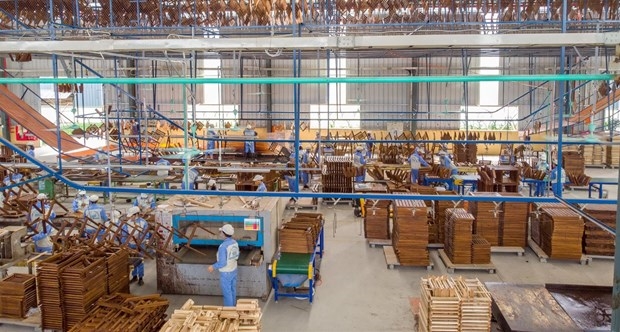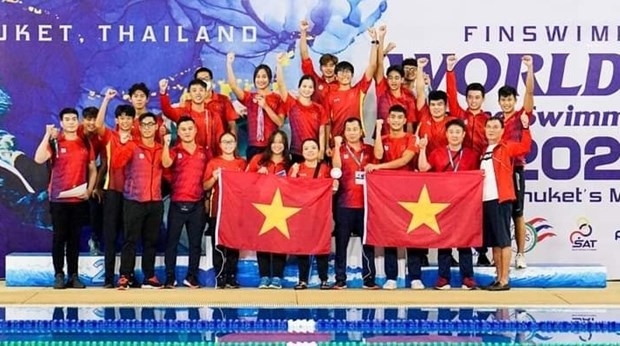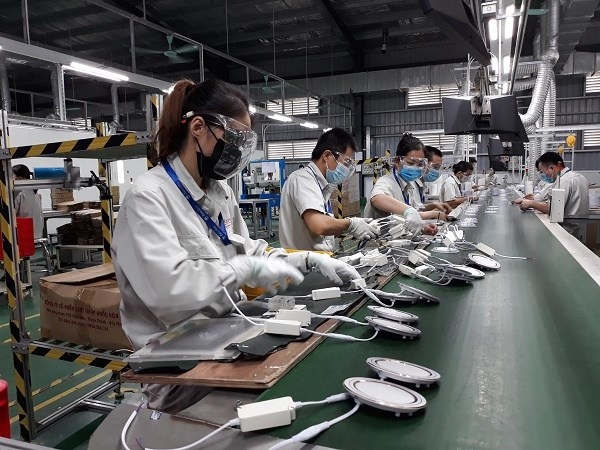 |
| Vietnam and Laos share a borderline of more than 2,300km which runs through 10 cities and provinces on each side. (Photo: VNA) |
Laos is currently Vietnam’s seventh biggest trade partner in the Association of Southeast Asian Nations (ASEAN) and the two countries are striving to raise two-way trade to 2 billion USD.
Vietnam and Laos share a border of more than 2,300km which runs through 10 cities and provinces on each side. Notably, there are nine international border gates, six main gates, 18 auxiliary gates and many trails, along with nine border gate economic zones.
Vietnam is among the three biggest investors in Laos. Bilateral trade reached 1.37 billion USD in 2021, a year-on-year rise of 33.32%, the highest over the past decade.
Vietnam’s exports to Laos reached 594.7 million USD, up 4%,while imports hit 778.2 million USD, up 69.8%.
 |
| Illustrative image (Source: VNA) |
In the first seven months of this year, trade revenue hit 948.9 million USD, representing an increase of 24.2% from the corresponding time last year, of which Vietnam’s exports to Laos were valued at 362.9 million USD, down 1.6% year-on-year, while its imports stood at 586 million USD, up 48.2%.
According to Do Quang Hung, deputy head of the Ministry of Industry and Trade (MoIT)'s Asia-Africa Market Department, the two countries have utilised trade agreements to achieve growth of over 10% over the past nearly decade.
The target of 2 billion USD will be achieved soon, Hung said, urging Vietnamese firms to invest more in building their brands and raising their competitiveness in the host market.
Enterprises should study the trade deals to facilitate customs clearance, and optimise trade promotions, he continued.
Deputy Minister of Industry and Trade Do Thang Hai affirmed that Vietnam stands ready to share its experience and help Laos remove difficulties amid the complex development of the global economic and political situation.
The MoIT will coordinate with its Lao counterpart to roll out measures to boost bilateral trade ties, he pledged.
Hai noted that the two ministries have agreed to complete negotiations and sign a memorandum of understanding on border trade infrastructure development and connectivity between the two countries, and adjustments to the bilateral trade agreement to ensure the interests of Vietnamese and Lao businesses and facilitate their sustainable development.
Vietnam ranks first at Finswimming World Cup Round Swimming Pool 2022
Vietnam topped the Finswimming’s World Cup Round Swimming Pool 2022 in Thailand after securing 26 gold, 11 silver, and five bronze medals.
 |
| The Vietnamese team (Photo: qdnd.vn) |
The Vietnamese squad had 18 swimmers guided by coach Le Minh Ngoc.
The achievements were the most successful of the Vietnamese team since they obtained 10 gold medals at the 31st Southeast Asian Games.
At the event (Photo: qdnd.vn)
The CMAS-World Underwater Federation’s tournament took place from September 2-5, with its previous rounds held in Hungary, Italy, Germany, and the US. Its final round is slated for October 28-30 in Poland.
Industrial production recovers quickly with growth of 9.4% in eight months
The index of industrial production (IIP) in the first eight months of 2022 surged 9.4% over the same period last year, according to the General Statistics Office (GSO).
 |
| Vietnam's industrial production in August 2022 continued the trend of rapid recovery with an increase of 2.9% over the previous month and 15.6% year on year. (Photo: chinhphu.vn) |
The office said that industrial production in August 2022 continued the trend of rapid recovery with an increase of 2.9% over the previous month and 15.6% year on year due to the efforts of enterprises in expanding production to offset the period affected by the COVID-19 pandemic.
Compared to the same period last year, the IIP growth rate in August reached 16.2% for the processing and manufacturing industry; 14.8% for electricity production and distribution; 11% for water supply, and management and treatment of garbage and wastewater; and 10.2% for the mining industry.
During the eight months, the processing and manufacturing industry posted the highest IIP growth of 10.4%. It was followed by electricity production and distribution (6.8%), water supply industry, garbage and wastewater treatment and management (5.8%) and the mining industry (4.2%).
The GSO report also showed that, in the past eight months, IIP of some key industrial products increased sharply compared to the same period last year, including beer (31.2%); processed seafood (20.7%); phone components (19.6%); automobiles (13.9%); casual wear (12.7%); leather shoes and sandals (12.5%); and tobacco (9.6%).
Meanwhile, some other products saw a decline of IIP compared to the same period last year, such as iron and crude steel (12.3%); televisions (10.7%); fertiliser NPK (6%); fabrics made from man-made fibers (5.8%); mobile phones (5.4%); aquatic feed (4.9%); liquefied petroleum gas (LPG) (2.4%); and crude oil exploitation (1%).
GSO also reported 61 out of 63 provinces and cities gained growth, while the rest of two localities had IIP reduction in the first eight months of 2022.
Of which, some localities achieved a relatively high increase in IIP due to industrial production growth in the processing and manufacturing industries; and electricity generation and distribution industry.
Meanwhile, some other localities had low manner in IIP growth rate or reduction in this index because the enterprises faced many difficulties from the impact of the pandemic.
Bac Giang province achieved the highest IIP of 51% during the first eight months.
Some other localities also had high IIP index due to strong recovery in the processing and manufacturing industry; and electricity production and distribution, such as Lai Chau, Dak Lak, Son La, Quang Nam, and Khanh Hoa.
Besides that, many difficulties in production and business activities made Tra Vinh and Ha Tinh provinces witness a reduction in IIP at 27% and 15%, respectively.
The number of employees working in industrial enterprises as of August 1, 2022 increased by 0.6% on month and 23% on year.
According to the Ministry of Industry and Trade, production in industrial centres is showing positive signs of recovery. However, the lack of human resources is one of the major obstacles that the enterprises are facing on the way of production recovery.
Pham Thi Tinh from the Vietnam Alliance for Industrial Support said after a long break due to the pandemic, the skills of workers have decreased, so the enterprises must spend time and expense on retraining. The cost of labour in the industrial sector has increased, but it is still not enough to attract workers.
In addition, the Ministry of Industry and Trade said that manufacturing enterprises need to diversify markets importing raw materials as well as exporting goods to avoid dependence.
There should be more policies to develop supporting industries in Vietnam to gradually become self-sufficient in raw materials. This is the core issue for sustainable industrial development in Vietnam.
The ministry also noted that it is necessary to continue changing industrial restructuring in the direction of developing the manufacturing industry and reducing processing and assembling for industrial products made in Vietnam.
Quang Ninh further implements zero- plastic-waste Ha Long Bay programme
Authorities in the northern province of Quang Ninh has approved a proposal to continue a zero-plastic-waste programme on the local Ha Long Bay, a UNESCO World Heritage Site.
 |
| Ha Long Bay (Soure: VNA) |
Accordingly, organisations and individuals working in tourism and services on the waters commit not to use, buy and sell single-use plastic products, replacing them with environmentally friendly ones.
Communications are set to be strengthened for tourists not to bring single-use plastic products onboard and use during their cruises around Ha Long Bay. Ship owners are advised to take measures to refuse transportation in cases where customers intentionally do not comply with this regulation.
The pilot of the programme began on September 1, 2019. It has so far attracted the participation of 270 businesses, ship owners, kayak service providers, and fish farmers. Meanwhile, nearly 30 fishing vessels have joined collecting thousands of tonnes of waste in the area.
The programme has helped reduce 90% of disposable plastic waste at attractions on the bay and 94% of the number of foam buoys on floating works of organisations and individuals engaged in tourism business and service activities on the bay.
Ha Long Bay is one of Vietnam’s most popular travel destinations.
An estimate in 2020 by the Ending Plastic Pollution Innovation Challenge (EPPIC) project showed that among over the 28,280 tonnes of plastic waste released in the Ha Long Bay area each year, about 5,272 could be discharged to the sea, and 34 tonnes of waste came from tourism activities every day./.